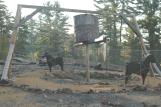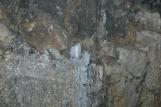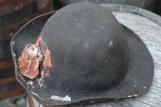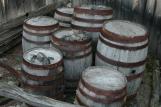4
There would be a preliminary sort in the mine, separating wall rock and ore rock. The ore would be placed in the kibble buckets in the mine and hoisted to the surface through the headframe, and dumped by a miner, referred to as the "lander".5
Buck O'Donnell sketch of 'The Windlass' from 'The Old Timers' collection on Cornish miners.1966
Bruce Mines, Ontario, Canada
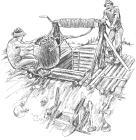
6
The methods used to hoist the kibble buckets to the surface were by manpowered windlass, or after the shaft became too deep, a horse powered "whim".8
In 1846 and 1847 steam engines were being used in England but had not yet been introduced to the Bruce Mines area.The Simpson Mine Shaft contains a reconstructed whim. Ropes are wound around a large drum, then over several pulleys to hang down through the head frame into the shaft. The horses would walk around in a circle, lowering an empty bucket while simultaneously raising a full bucket. When the full bucket reached the surface, the horses were stopped, and the "lander" would dump the bucket. After the bucket was emptied, the horses then went in the opposite direction, lowering the empty bucket while bringing up another full one. This routine continued throughout the day.
9
Boys, eight years or older worked above ground and would hand sort the rock, separating fragments containing ore from the stony pieces. These fragments would be reduced to small pieces, and then sorted into three separate grades. First would be the "prill" or solid ore, then "best work", ore slightly intermixed with foreign matter, and finally "poor dredge" the fragments of the poorest kind. In the Cornwall mines the ore was broken up and sorted by the "bal maidens", or female surface workers, but there is no record of female labour at the Bruce Mines.11
In 1846, down in the mineshaft, candles were the only source of light. It is said that the miners could gauge the amount of time spent in the shaft by the length of candle burned.13
The miners' hats were bowlers that were lacquered to a hard finish. A candle was attached to the front with clay.15
When smelting operations were not available, the handpicked ore was packed in barrels and shipped to Swansea, Wales. Smelting operations, in Bruce Mines, were built in 1847 by the Montreal Mining Company.16
Different methods of working the mine were used in the early years.The Tut System
The miners were paid according to the quantity of ground cut. This was beneficial in that the "passageways were roomy and followed definite directions." It was detrimental in that the miners were not particularly concerned with the quality of the ore being taken out.
The Tribute System
This was used for a short time in 1852. The miners were paid per ton of ore dressed. This was detrimental in that "it was less safe because the miners followed only the rich veins; shafts and tunnels were honey-combed and narrow." It was financially beneficial for the company, but many miners refused to work under the 'tribute system'. Due to the high price of copper in 1853 and 1854, (up to £140 per ton) the company returned to the 'tut system' in order increase the output of the mine and to retain sufficient numbers of miners.
